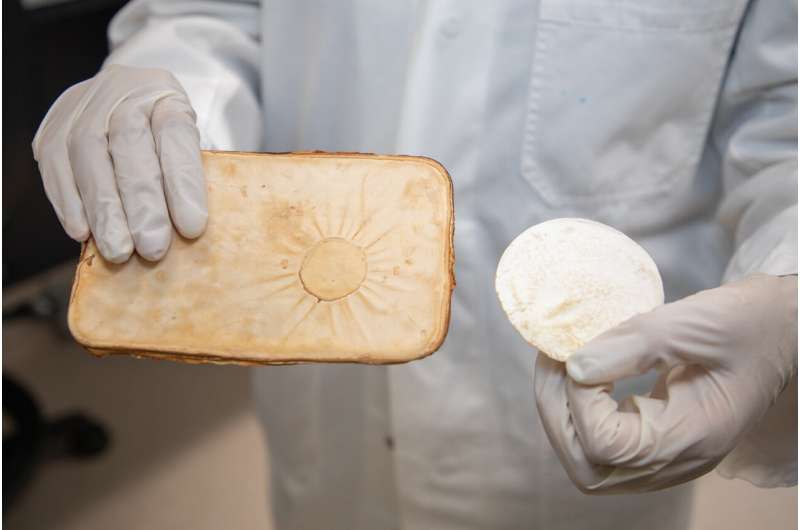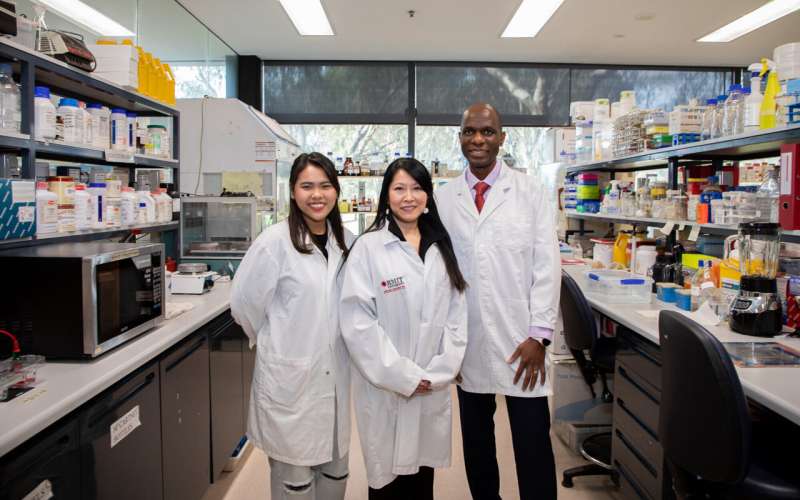This article has been reviewed according to Science X's editorial process and policies. Editors have highlighted the following attributes while ensuring the content's credibility:
fact-checked
peer-reviewed publication
trusted source
proofread
Fungi could be the key to sustainable fireproofing

Mycelium, an incredible network of fungal strands that can thrive on organic waste and in darkness, could be a basis for sustainable fireproofing. RMIT researchers are chemically manipulating its composition to harness its fire-retardant properties.
Associate Professor Tien Huynh, an expert in biotechnology and mycology, said they've shown that mycelium can be grown from renewable organic waste.
"Fungi are usually found in a composite form mixed with residual feed material, but we found a way to grow pure mycelium sheets that can be layered and engineered into different uses—from flat panels for the building industry to a leather-like material for the fashion industry," said Huynh, from the School of Science.
The novel method of creating mycelium sheets that are paper-thin, like wallpaper, works without pulverizing the mycelium's filament network. Instead, they used different growth conditions and chemicals to make the thin, uniform and—importantly—first resistant, material.
Fungi fireproofing our buildings
The researchers are focused on creating bio-derived, fire-retardant cladding for buildings to prevent tragedies like the Grenfell Tower fire, in which the deadly blaze was accelerated by a highly combustible cladding component.
Associate Professor Everson Kandare, an expert in the flammability and thermal properties of biomaterials and co-author of the paper, said the mycelium has strong potential as a fireproofing material.
"The great thing about mycelium is that it forms a thermal protective char layer when exposed to fire or radiant heat. The longer and the higher temperature at which mycelium char survives, the better its use as a fireproof material," said Kandare.
Beyond being effective, mycelium-based cladding can be produced from renewable organic waste and is not harmful to the environment when burned, he explained.
Where composite cladding panels are used, they usually contain plastics—which produce toxic fumes and heavy smoke when they burn.

"Bromide, iodide, phosphorus and nitrogen-containing fire retardants are effective, but have adverse health and environmental effects. They pose health and environmental concerns, as carcinogens and neurotoxins that can escape and persist in the environment cause harm to plant and animal life," said Kandare.
"Bioderived mycelium produces naturally occurring water and carbon dioxide."
Bringing the research to life
This research could eventually lead to improved and eco-friendly cladding for buildings.
"Plastics are quick and easy to produce, whereas fungi is slow to grow and relatively harder to produce at scale," said Huynh.
"However, we've been approached by the mushroom industry about using their fungal-incorporated waste products. Collaborating with the mushroom industry would remove the need for new farms while producing products that meet fire safety needs in a sustainable way."
The paper, "Fireproofing flammable composites using mycelium: Investigating the effect of deacetylation on the thermal stability and fire reaction properties of mycelium," is published in the journal Polymer Degradation and Stability.
It builds on preliminary research previously published by the experts in the journals, Polymer Degradation and Stability and Scientific Reports.
The researchers are now looking to create fungal mats reinforced by engineering fibers to delay ignition, reduce the flaming intensity and improve fire safety ranking.
More information: Nattanan Chulikavit et al, Fireproofing flammable composites using mycelium: Investigating the effect of deacetylation on the thermal stability and fire reaction properties of mycelium, Polymer Degradation and Stability (2023). DOI: 10.1016/j.polymdegradstab.2023.110419
Nattanan Chulikavit et al, Influence of growth rates, microstructural properties and biochemical composition on the thermal stability of mycelia fungi, Scientific Reports (2022). DOI: 10.1038/s41598-022-19458-0
Journal information: Scientific Reports
Provided by RMIT University





















